June 2021
I recently wrote about the benefits of adopting a holistic approach to fitness, so I thought I’d complement that story by sharing the details of my approach to living a healthy lifestyle.
To start, I follow a simple four-step health checklist:
- Eat a healthy diet
- Exercise regularly
- Prioritize recovery and rest—and get quality sleep
- Choose the right supplements (quality matters!)
I adhere to this checklist, but I also recommend it to my friends, family, and patients. Are you interested in learning if this approach is right for you? Let us take a closer look at each of these categories—plus share my tips for adhering to a lifestyle that leads to a healthier, happier you—below.
Eat a healthy diet
My mantra is “food is information,”—and good food signals health information. Instead of counting calories or fat grams, I count chemicals to determine the healthiest foods to eat. The chemical count needs to be as low as possible, so I don’t eat processed foods full of sugar, bad fats, additives, and preservatives. My diet consists of mostly organic and chemical-free foods, including organic fruits and vegetables, minimally processed plant-based products, nuts, beans, wild fish, pasture-raised eggs, grass-fed or grass-finished meats, and ancient grains such as quinoa and steel-cut oats. For cooking, I use cold-pressed extra-virgin olive oil, avocado oil, and grapeseed oil. I use walnut oil and flaxseed oil in salad dressings and to top vegetables. Overall, I aim for a diet that’s about 70 percent or more plant-based, low in carbohydrates, moderate in protein, and rich in good fats from plant oils and fish.
Missing from my diet? Sugar, salt, dairy products, and gluten from wheat products.
As for liquids, I drink plenty of plain water, plus organic teas and coffee. Yes, even my liquids are organic. Nonorganic teas and coffee are usually grown using chemical pesticides and herbicides that end up in the final product and can negatively affect your health. Many studies have shown that coffee, even the decaffeinated kind, is good for you. Among other benefits, it’s a great source of antioxidants—and so is green tea.
Exercise regularly
I’m an ardent fan of exercising regularly, whether it’s just a brisk walk or partaking in a sporting event. My routine typically consists of exercising six days a week—even with my heavy travel schedule. I incorporate weight or resistance training three to four days a week, cardiovascular training approximately four days a week, and flexibility moves virtually every day.
Exercise starts my power batteries for the day. And my goals are simple: have fun with it and stay injury-free. For more information on the latter, keep reading.
Prioritize recovery and rest—and get quality sleep
Rest is a critical element of your health equation—and a component that is often overlooked. Quality sleep allows your brain to recover from the day’s events and detox its chemicals.
Good sleep also enhances cognition, concentration, productivity, problem-solving skills, and memory. Meanwhile, poor sleep has been shown to impair brain function.
As a rule of thumb, I aim for seven hours of quality sleep per night—and recommend that you do, too.
I also encourage you to rest between rigorous workouts, as this allows for your body to recover. Immediately following a workout, be sure to cool down and stretch. An after-workout stretch allows your heart rate to return to its normal rate and helps prevent future soreness.
If you do experience soreness after your workouts, there’s support available to help you get back to feeling your best. I talk more about choosing the right supplements to fit your healthy lifestyle below.
Choose the right supplements
The key to choosing quality supplements is finding ones that use top-level ingredients. As a consumer and a practitioner, transparency, and quality are critical to me. Before I recommend any supplement to a patient, I rigorously evaluate and then research the quality of the ingredients to ensure they do not contain pesticides, fillers, and/or gluten.
To support my healthy lifestyle, I take BioAstin Astaxanthin—a natural antioxidant found in certain species of plants, animals, and microalgae. It’s my go-to supplement for recovery from my long work hours and exercise. Since incorporating BioAstin into my armamentarium, my joint soreness has precipitously dropped, and I’ve been injury-free.†*
I also recommend it to my active patients because it provides optimal results that they feel in between workouts, such as decreased joint soreness, reduced fatigue, and enhanced recovery.*
Additionally, I’ve found BioAstin synergistic for health with other essential supplements, including vitamin D, probiotics, and fish oils.
The ingredients in BioAstin are grown in a production process that uses large freshwater ponds that mimic the natural environment and an extraction process that uses high-pressure CO2—free of any chemical solvents—to extract the astaxanthin from the algal cells. BioAstin is free of pesticides, herbicides and is iGen Non-GMO verified.
Following this four-pronged approach to health works for me, and it will work well for anyone who wants to prioritize a healthy lifestyle. Eating organic (and chemical-free) foods, exercising regularly, prioritizing rest and sleep, and choosing supplements with the highest quality ingredients will help you accomplish not only your fitness goals but also lead a healthier life—both now and in the long run.
BioAstin is offered in 4mg or convenient one-per-day 12mg soft gels and is available in formulations that combine Hawaiian Astaxanthin and premium ingredients to support specific structures in the body like your eyes and joints. More information about BioAstin can be found here.
*These statements have not been evaluated by the Food and Drug Administration. This product is not intended to diagnose, treat, cure, or prevent any disease. †Results may vary.
Dr. Silverman is a member of Nutrex Hawaii's Scientific Advisory Board.
Contact your healthcare provider prior to beginning any new exercise or diet plan.

